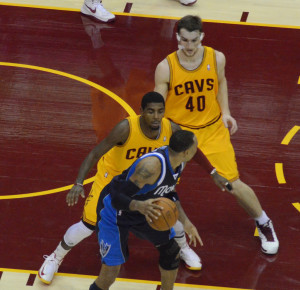Packing the Lanes in Defence: Advanced Tactics in Defence

Packing the Lanes in defence is the practice of having help defenders assist earlier in the defences’ rotations to stop offensive penetration by a dribbler. This tactic is commonly used against teams with a particularly prolific scorer and can be seen in the National Basketball Association (NBA) in most games. The aim of packing the lanes is simply to force the offensive team into finding another shooting opportunity. However, there is more to the tactic then just over playing in help defence…
When packing the lanes the defence must choose where and when the help defence is to rotate. Some of the more commonly seen rules are for example when there is middle penetration by the offensive teams help defenders must stop the dribbler before they move below the foul line or into the keyway. This means instead of the defensive players being one pass away from the ball, jumping to the ball side and being one-step off their defensive assignment. These players will be in an open stance and be anywhere up to three steps off their defensive match-up.
One of the significant advantages of packing the lanes in defence if used by teams regularly is eventually the tactic can be used against individual players. This is very advantageous in nullifying a particular player who is the outright dominate scorer for a team without employing the tactic against other players who do not require the over-playing help defence and risk associated. This approach has particular advantages in limiting the output of the dominant player while also not presenting a regular pattern or strategy of the team’s defence. This will make the tactic of packing the lanes harder to adjust to for the offensive team and should see the offense slower to recognise the strategy initially because it is only being employed specifically against a player, but then clocked by the team’s standard man-to-man principles against the rest of the offensive players.
A weakness of the packing the lanes is that with the increased attention to helping in defence comes the realisation that other offensive players will be not guarded as tightly as when standard man-to-man defensive principles are employed.
With any defensive tactic, there are always strengths and weaknesses to the strategy. No one defence is universally fantastic against all offensive strategies and systems. It is the role of a coach to match the need in defence with what is going to challenge most the offensive output of the opposition.
When packing the lanes in defence there are some simple principles of play to help achieve the best outcomes for the defence. These are:
- Dribbler must be stopped before advancing a foot into the keyway (when the dribble penetration is to the middle of the floor)
- Help defenders look to block the driving lane with their feet, initiating contact with the offensive player only with the centre of the chest; no reaching or lazy defensive effort
- Help rotations should never come in the first instance from the low post defender
- If a pass is made by the dribbler once stopped through packing the lanes, the defensive players involved in the action recover first to the split line (High or Low); this will help players rotate more quickly back into a possible help defence position
- The first pass from the dribbler must be contested; this will be the desired counter by the offensive team when facing a defence packing the lanes. The defence must look to force the additional pass away from the offenses desired first passing target. The better a defence becomes in contesting the passes after the dribbler is stopped, the more likely the defence will be ultimately be effective in preventing a scoring possession by the offense.
- The desired scoring outcome is long-range contested two point shot by a third option (or lower) scorer
- Defensive players must “bury” the closest offensive player away from keyway
Packing the lanes can be a very useful tool in making offenses play outside of what their desired offense is. The better a defence becomes at utilising this tactic the more passes and subsequent options an offense will need to be able to make to find a favourable shot.
Related articles







